Temporal Model for Ship Twin-Propeller Jet Induced Sandbed Scour
Abstract
1. Introduction
2. Previous Scour Model by Single Propeller
3. Experimental Setup
3.1. Experiment Setup
3.2. Measurement System
3.3. 3D Printing for Twin-Propeller
3.4. Scaling of Experiment
4. Estimation of Twin-Propeller Induced Scour
4.1. Dimensional Analysis of Scour by Twin Propeller
4.2. Empirical Constants C1, C2, A and B
4.3. Implementation of Equations on Full-Scale Vessel
5. Comparison
6. Conclusions
Author Contributions
Funding
Acknowledgments
Conflicts of Interest
Notation
| A = corrections factors; |
| B = corrections factors; |
| C = clearance distance from propeller tip to bed; |
| C1 = corrections factors; |
| C2 = corrections factors; |
| Ct = thrust coefficient; |
| Dh = propeller hub diameter; |
| = propeller diameter; |
| dp = distance between twin-propeller; |
| d50 = average sediment grain size; |
| F0 = densimetric Froude number; |
| = characteristic length; |
| n = number of revolutions per second; |
| N = blade number; |
| P’ = pitch ratio (pitch/diameter); |
| = Reynolds numbers for propeller jet; |
| = Reynolds numbers for propeller model; |
| T = propeller thrust; |
| t = time; |
| V0 = efflux velocity; |
| = maximum deposition height of twin-propeller at time t; |
| = experimental coefficient for single-propeller; |
| = experimental coefficient for twin-propeller; |
| = experimental coefficient for single-propeller; |
| = experimental coefficient for twin-propeller; |
| = projected area ratio; |
| = depth of maximum scour of single-propeller at time t; |
| = depth of maximum scour of twin-propeller at time t; |
Appendix A
- The dimensions of each physical quantity:
- dim () = L; dim () = LT−1; dim () = L; dim () = L; dim () = L; dim () = L−3M; dim () = LT−2; dim () = L−3M; dim () = L2T−1; dim () = L.
- There are 10 physical quantities, involving 3 basic dimensions: L, T, M. End up with 7 dimensionless coefficients.
- Select the basic physical quantity from 10 physical quantities as .The rest of the physical quantities are expressed in the form of the power product of the basic physical quantities.
- ,
- ,
- ,
- ,
- ,
- ,
- ,
- The dimensionless functional relation is expressed as:
References
- Kim, Y.G.; Kim, S.Y.; Kim, H.T.; Lee, S.K.; Yu, B.S. Prediction of the manoeuvrability of a large container ship with twin-propeller and twin rudders. Mar. Sci. Technol. 2007, 12, 130–138. [Google Scholar] [CrossRef]
- Albertson, M.L.; Dai, Y.B.; Jensen, R.A.; Rouse, H. Diffusion of submerged jets. Trans. Am. Soc. Civ. Eng. 1950, 115, 639–697. [Google Scholar]
- Blaauw, H.G.; van de Kaa, E.J. Erosion of Bottom and Sloping Banks Caused by the Screw Race of the Manoeuvring Ships; Rep. No. 202; Delft Hydraulics Laboratory: Delft, The Netherlands, 1978. [Google Scholar]
- Verhey, H.J.; Blockland, T.; Bogaerts, M.P.; Volger, D.; Weyde, R.W. Experiences in Netherlands with quay structures subjected to velocities created by bow thrusters and main propellers of mooring and unmooring ships. Perm. Int. Assoc. Navig. Congr. 1987, 58, 69–88. [Google Scholar]
- Hamill, G.A. The scouring action of the propeller jet produced by a slowly manoeuvring ship. Perm. Int. Assoc. Navig. Congr. 1988, 61, 85–110. [Google Scholar]
- Lam, W.H. Simulation of Ship Propeller Jet. Ph.D. Thesis, Queen’s University of Belfast, Belfast, UK, 3 July 2008. [Google Scholar]
- Jiang, J.; Lam, W.H.; Cui, Y.; Zhang, T.; Sun, C.; Guo, J.; Ma, Y.; Wang, S.; Hamill, G. Ship Twin-propeller Jet Model used to Predict the Initial Velocity and Velocity Distribution within Diffusing Jet. KSCE J. Civ. Eng. 2019, 23, 1118. [Google Scholar] [CrossRef]
- Lam, W.H.; Hamill, G.A.; Robinson, D.; Raghunathan, S. Observations of the initial 3D flow from a ship’s propeller. Ocean Eng. 2010, 37, 1380–1388. [Google Scholar] [CrossRef]
- Hong, J.H.; Chiew, Y.M.; Cheng, N.S. Scour Caused by a Propeller Jet. J. Hydraul. Eng. 2013, 139, 1003–1012. [Google Scholar] [CrossRef]
- Hamill, G.A.; Johnston, H.T.; Stewart, D.P. Propeller wash scour near quay walls. Waterw. Port Coast. Ocean 1999, 125, 170–175. [Google Scholar] [CrossRef]
- Wang, S.; Lam, W.; Cui, Y.; Zhang, T.; Jiang, J.; Sun, C.; Guo, J.; Ma, Y.; Hamill, G. Novel energy coefficient used to predict efflux velocity of tidal current turbine. Energy 2017. [Google Scholar] [CrossRef]
- Sun, C.; Lam, W.; Cui, Y.; Zhang, T.; Jiang, J.; Guo, J.; Ma, Y.; Wang, S.; Hamill, G.; Lam, S. Empirical model for Darrieus-type tidal current turbine induced seabed scour. Energy Convers. Manag. 2018, 171, 478–490. [Google Scholar] [CrossRef]
- Ma, Y.B.; Lam, W.; Cui, Y.; Zhang, T.; Jiang, J.; Sun, C.; Guo, J.; Wang, S.; Hamill, G.; Lam, S. Theoretical vertical-axis tidal-current-turbine wake model using axial momentum theory with CFD corrections. Appl. Ocean Res. 2018, 79, 113–122. [Google Scholar] [CrossRef]
- Mujal-Colilles, A.; Gironella, X.; Crespo, A.J.C.; Sanchez-Arcilla, A. Study of the Bed Velocity Induced by Twin Propellers. J. Waterw. Port Coast. Ocean Eng. 2017, 145, 04017013. [Google Scholar] [CrossRef]
- Yew, W.T. Seabed Scour Induced by Twin-Propeller Ships. Ph.D. Thesis, University of Malaya, Kuala Lumpur, Malaysia, 11 October 2017. [Google Scholar]
- Cui, Y.; Lam, W.; Zhang, T.; Sun, C.; Hamill, G. Scour Induced by Single and Twin Propeller Jets. Water 2019, 11, 1097. [Google Scholar] [CrossRef]
- Bergh, H.; Magnusson, N. Propeller erosion and protection methods used in ferry terminals in the port of Stockholm. Perm. Int. Assoc. Navig. Congr. 1987, 58, 112–120. [Google Scholar]
- Chait, S. Undermining of quay walls at South African ports due to the use of bow thrusters and other propeller units. Perm. Int. Assoc. Navig. Congr. 1987, 58, 107–110. [Google Scholar]
- Stewart, D.P.; Hamill, G.A.; Johnston, H.T. Bed scour considerations in ship berth design. In Proceedings of the International Conference on Coastal and Port Engineering in Developing Countries, Mombasa, Kenya, 16–20 September 1991; pp. 1110–1125. [Google Scholar]
- Sumer, B.M.; Fredsøe, J. The Mechanics of Scour in the Marine Environment; World Scientific: Singapore, 2002. [Google Scholar]
- Gaythwaite, J. Design of Marine Facilities for the Berthing, Mooring, and Repair of Vessels; ASCE: Reston, VA, USA, 2004. [Google Scholar]
- Hamill, G.A.; Kee, C. Predicting axial velocity profiles within a diffusing marine propeller jet. Ocean Eng. 2016, 124, 104–112. [Google Scholar] [CrossRef]
- Zhang, J.F.; Zhang, Q.H.; Maa, P.Y.; Qiao, G.Q. Lattice boltzmann simulation of turbulence-induced flocculation of cohesive sediment. Ocean Dyn. 2013, 63, 1123–1135. [Google Scholar] [CrossRef]
- Xu, D.; Bai, Y.; Ji, C.; Williams, J. Experimental study of the density influence on the incipient motion and erosion modes of muds in unidirectional flows: The case of huangmaohai estuary. Ocean Dyn. 2015, 65, 187–201. [Google Scholar] [CrossRef]
- Li, Y.; Yang, S.G.; Yu, S. Numerical simulation of installation process and uplift resistance for an integrated suction foundation in deep ocean. China Ocean Eng. 2016, 30, 33–46. [Google Scholar] [CrossRef]
- Li, M.; Kong, R.; Han, S.; Tian, G.; Qin, L. Novel method of construction-efficiency evaluation of cutter suction dredger based on real-time monitoring data. J. Waterw. Port Coast. Ocean Eng. 2018, 144, 05018007. [Google Scholar] [CrossRef]
- Tan, Q.M. Dimensional Analysis; China University of Science and Technology Press: Anhui, China, 2005. [Google Scholar]
- Kong, L. Fluid Mechanics I; Higher Education Press: Beijing, China, 2011. [Google Scholar]
- Mujal-Colilles, A.; Gironella, X.; Sanchez-Arcilla, A.; Puig Polo, C.; Garcia-Leon, M. Erosion caused by propeller jets in a low energy harbour basin. J. Hydraul. Res. 2017, 55, 121–128. [Google Scholar] [CrossRef]
- Tan, R.I.; Yuksel, Y. Seabed scour induced by a propeller jet. Ocean Eng. 2018, 160, 132–142. [Google Scholar] [CrossRef]
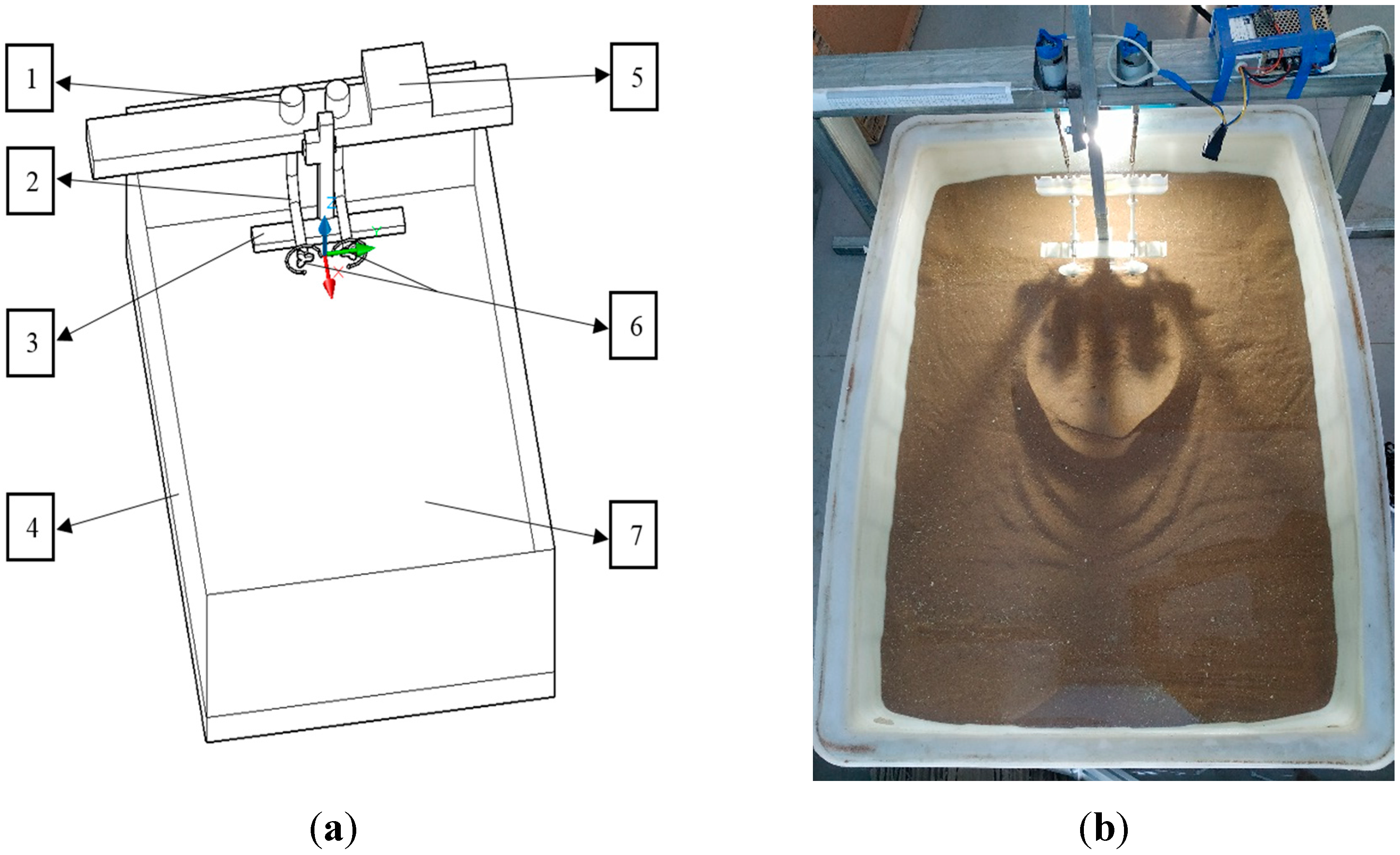
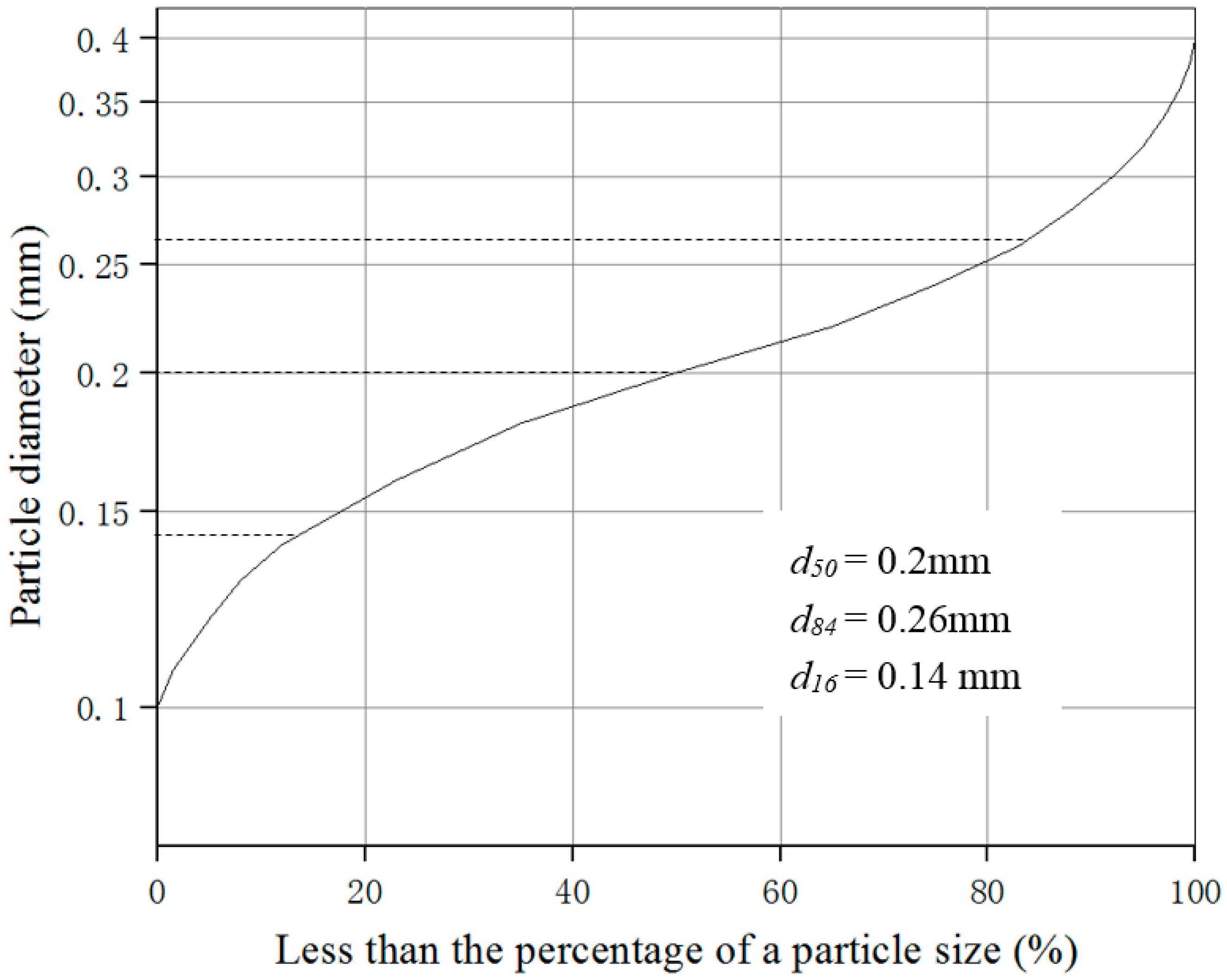


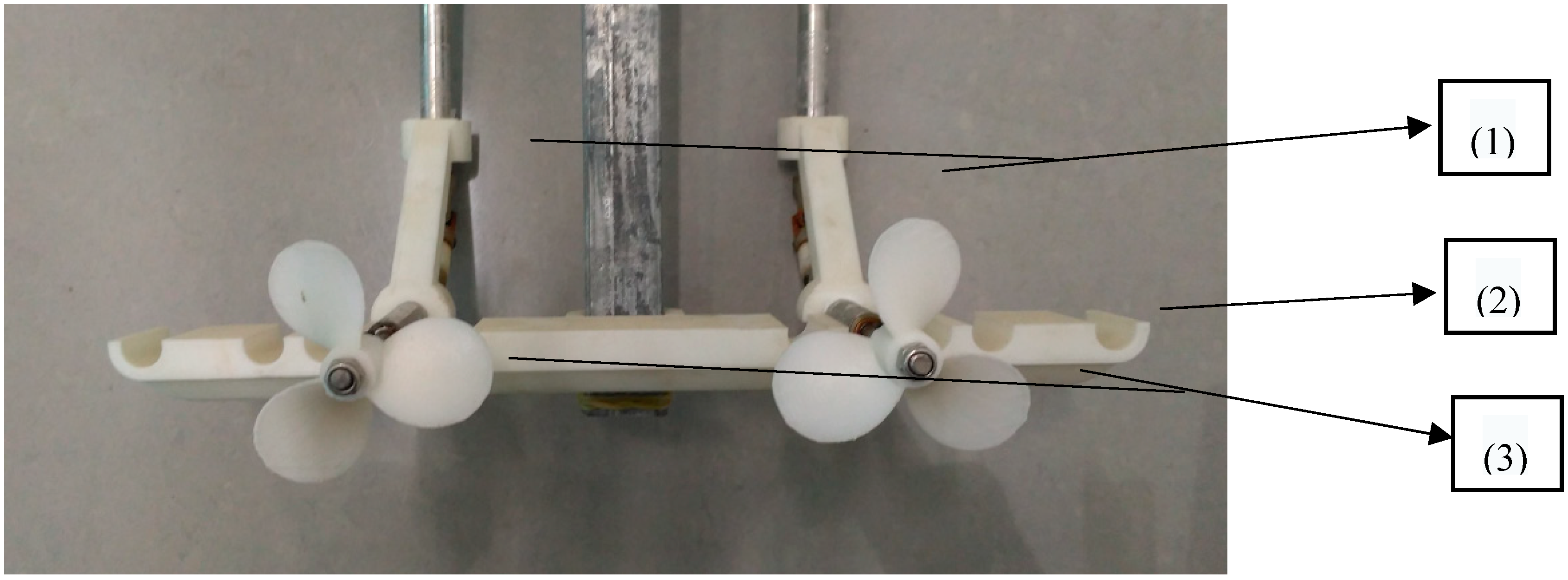
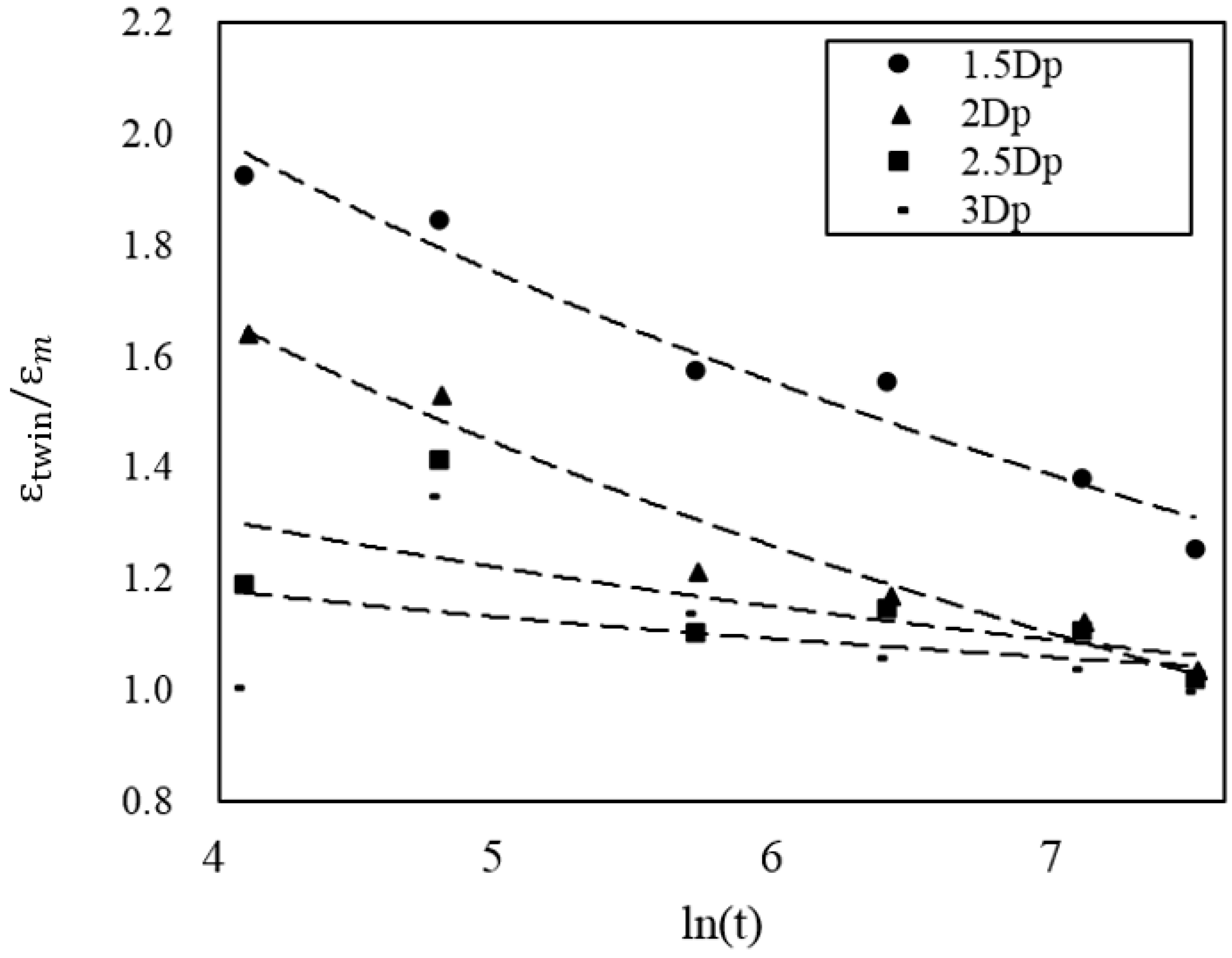
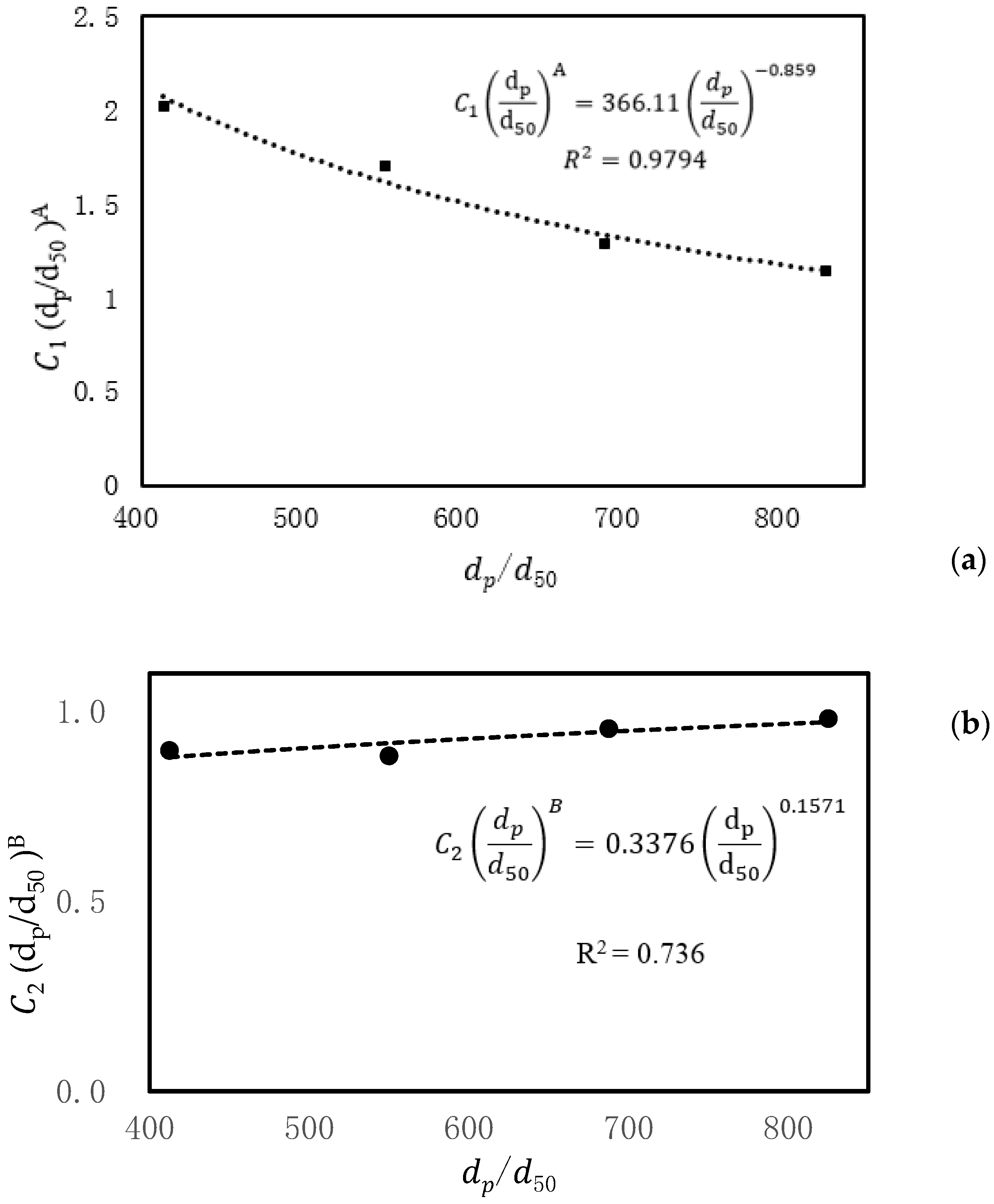

| Experiment Number | C (mm) | n (rpm) | V0 (m/s) | F0 | T (s) | |
|---|---|---|---|---|---|---|
| Twin-propeller TE-1 | 27.5 | 110 | 500 | 0.463 | 8.135 | 7200 |
| Twin-propeller TE-2 | 27.5 | 82.5 | 500 | 0.463 | 8.135 | 1800 |
| Twin-propeller TE-3 | 27.5 | 137.5 | 500 | 0.463 | 8.135 | 1800 |
| Twin-propeller TE-4 | 27.5 | 165 | 500 | 0.463 | 8.135 | 1800 |
| Twin-propeller TE-5 | 5 | 110 | 500 | 0.463 | 8.135 | 1800 |
| Twin-propeller TE-6 | 55 | 110 | 500 | 0.463 | 8.135 | 1800 |
| Single-propeller S-1 | 27.5 | / | 500 | 0.463 | 8.135 | 1800 |
| Propeller | (mm) | Ct | P′ | β | Dh (mm) |
|---|---|---|---|---|---|
| Propeller-55 (Present research) | 55 | 0.40 | 1.00 | 0.47 | 11.5 |
| dp | ||||
|---|---|---|---|---|
| 2.029 | 1.706 | 1.295 | 1.146 | |
| 0.897 | 0.883 | 0.955 | 0.981 |
| 1.5 Dp | 412.5 | 2.029 |
| 2.0 Dp | 550.0 | 1.706 |
| 2.5 Dp | 687.5 | 1.295 |
| 3 Dp | 825.0 | 1.146 |
| 1.5 Dp | 412.5 | 0.897 |
| 2.0 Dp | 550.0 | 0.883 |
| 2.5 Dp | 687.5 | 0.955 |
| 3 Dp | 825.0 | 0.981 |
| Researchers | Type of Propeller | Equations | Time-Dependent Scour Depth of 7200 s (mm) | Variation (%) |
|---|---|---|---|---|
| Proposedequation | Twin-propeller | 56.9 | - | |
| Hamill [5] | Single-propeller | 53.3 | 6 | |
| Hong et al. [9] | Single-propeller | 38.7 | 31 | |
| Yew [15] | Twin-propeller | 80.0 | 40 | |
| Mujal-Colilles et al. [29] | Single-propeller | Agree with Hong (2013) | 38.7 | 31 |
| Tan & Yuksel [30] | Single-propeller | 56.6 | 0.5 |
© 2019 by the authors. Licensee MDPI, Basel, Switzerland. This article is an open access article distributed under the terms and conditions of the Creative Commons Attribution (CC BY) license (http://creativecommons.org/licenses/by/4.0/).
Share and Cite
Cui, Y.; Lam, W.H.; Zhang, T.; Sun, C.; Robinson, D.; Hamill, G. Temporal Model for Ship Twin-Propeller Jet Induced Sandbed Scour. J. Mar. Sci. Eng. 2019, 7, 339. https://doi.org/10.3390/jmse7100339
Cui Y, Lam WH, Zhang T, Sun C, Robinson D, Hamill G. Temporal Model for Ship Twin-Propeller Jet Induced Sandbed Scour. Journal of Marine Science and Engineering. 2019; 7(10):339. https://doi.org/10.3390/jmse7100339
Chicago/Turabian StyleCui, Yonggang, Wei Haur Lam, Tianming Zhang, Chong Sun, Desmond Robinson, and Gerard Hamill. 2019. "Temporal Model for Ship Twin-Propeller Jet Induced Sandbed Scour" Journal of Marine Science and Engineering 7, no. 10: 339. https://doi.org/10.3390/jmse7100339
APA StyleCui, Y., Lam, W. H., Zhang, T., Sun, C., Robinson, D., & Hamill, G. (2019). Temporal Model for Ship Twin-Propeller Jet Induced Sandbed Scour. Journal of Marine Science and Engineering, 7(10), 339. https://doi.org/10.3390/jmse7100339






